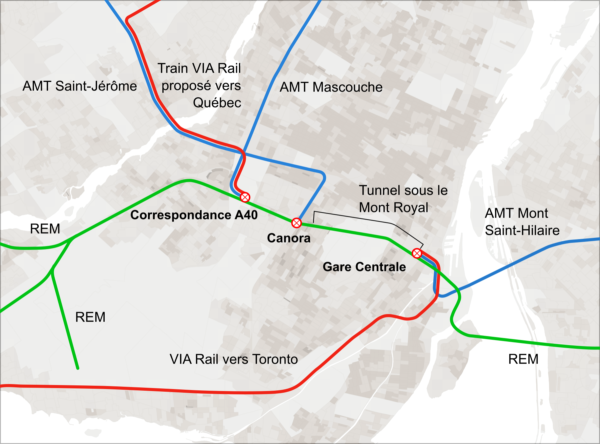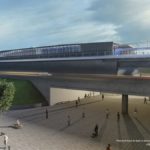La Controverse Autour du REM est Devenue une Guerre Médiatique…
October 17th, 2016 by ant6nEnglish version below. The following was written as a response to the most recent ‘opinion’ published by the CDPQInfra in La Presse and Le Devoir.
La controverse autour du REM est devenue une guerre médiatique… sur un projet de transport en commun! Ça n’a aucun sens. Le projet devrait être évalué selon son mérite, avec l’objectif de construire un réseau intégré de transport.
Au lieu de cela, on se chicane sur des faits. CDPQInfra ne cesse de publier des article pour “corriger†ceux qui soulèvent des problèmes. Mais CDPQInfra ne fait que souligner les chiffres en leur faveur et tente de brouiller le débat sur les chiffres qui leur sont défavorables, pour nous convaincre que le REM est économiquement viable.
Par exemple, leur plus récent article paru dans La Presse et Le Devoir compare le coût de construction par kilomètre du REM avec celui du Canada line et du Confederation line, pour montrer que le chiffre est inférieur pour le REM, ce qui en ferait un meilleur projet.
Mais cette comparaison n’est simplement pas pertinente! Les lignes Canada et Confederation ont été construites de zéro; des tunnels neufs ont été creusés dans le centre-ville, la partie la plus onéreuse des projets. C’est complètement différent du REM: la moitié de la ligne et le tunnel existent déjà ! Il est donc tout à fait normal que le coût par kilomètre soit moindre. Cela n’en fait pas un meilleur projet, malgré ce que CDPQInfra voudrait prétendre.
Le coût par kilomètre est un chiffre que la CDPQ brandit à tout vent car elle obscurcit tous les problèmes qui font du projet un mauvais investissement:
1) l’utilisation inefficace de l’infrastructure existante, particulièrement du tunnel du Mont Royal. Cet actif stratégique devrait être partagé entre le REM, les lignes de l’AMT et de Via Rail, mais la CDPQ refuse de prendre en considération un tel partage, car ils n’ont que faire des coûts occasionnés aux autres agences, ni du développement à long terme du transport à Montréal. Sans accès au tunnel, les lignes de l’AMT et de VIA Rail ne pourront jamais réaliser leur plein potentiel.
La CDPQ continue de prétendre que ce partage est impossible technologiquement, prétention réfutée à maintes reprises par des experts indépendants et par Via Rail.
2) la reconstruction non-nécessaire de la ligne Deux-Montagnes. Contrairement à ce que la CDPQ laisse entendre, la reconstruction n’augmentera en rien la capacité aux heures de pointe. Le REM ne fera qu’étendre le service durant la journée, alors que l’infrastructure actuelle permet d’atteindre ce résultat avec des améliorations beaucoup moins chères.
3) les antennes vers l’Ouest de l’Île génèreront très peu d’achalandage. La ligne est construite sur le bord de l’autoroute, là où très peu de gens habitent, et est mal connecté au réseau d’autobus. La ligne dépend presque exclusivement sur le parking incitatif, davantage même que les trains de banlieues existantes, ce qui en limitera l’achalandage.
Si le REM n’est pas fait pour maximiser la fréquentation, pas construit pour optimiser l’infrastructure existante, pourquoi voulons-nous aller de l’avant? Parce que nous avons mandaté une entité privée pour planifier notre transport en commun, à profit. Beaucoup de profit. Ce profit, qui sera extrait du public québécois, car nous devrons repayer la contribution de la Caisse d’une façon ou d’une autre.
Et ce motif de profit explique la guerre médiatique. La CDPQ veut le projet, même s’il ne fait aucun sens, même s’il ne maximise pas l’utilité publique, car elle n’est concernée que par le profit. Nos agences gouvernementales sont restées particulièrement silencieuses sur ce projet, et la plupart se sont rangés derrière la CDPQ malgré les failles du projet.
Étant donné l’inaction de nos institutions publiques, c’est au public québécois de s’assurer que la CDPQ soit redevable, et de demander les améliorations qui s’imposent.
The REM controversy has become a media war
The REM controversy has become a media war — over a transit project! It’s completely crazy. It should be about merit, about weighing positive and negative impacts. About building an integrated, regional transit network.
Instead, we’re arguing about facts. The Caisse keeps writing articles trying to ‘correct’ people bringing up issues. The Caisse only highlights facts to try to make them look good, and misleading the public about others, all to prove that their project supposedly makes financial sense.
For example, in the most recent article in La Presse et Le Devoir, CDPQInfra compares the construction cost per kilometre of the REM with the Canada line and Confederation line – showing that it is lower, supposedly to prove theirs is a much better project.
But this comparison is simply not apt. The Canada and Confederation lines were built from scratch, including downtown tunnels, which is the costliest part. This is completely unlike the REM: Half the the line already exists today; the downtown tunnel exists today. Most of the new stretches are along highways, where it is cheaper to build, but where it will have less ridership. It is normal that the cost per km is lower, but, contrary to what the CDPQ wants us to believe, that doesn’t mean it’s a better project.
The cost per kilometre is a number that the Caisse provides try to obfuscate the problems that make this project an inefficient investment:
1) The inefficient utilization of existing infrastructure. In particular the Mount Royal tunnel. This strategic infrastructure asset should be shared by REM, three AMT lines and VIA. But the Caisse simply refuses to consider sharing, because they do not care about the cost to other transit agencies and long-term transit development in Montreal. Without direct access to downtown, the AMT and VIA lines they will never be able to realize their full ridership potential.
Instead they’re arguing about whether a shared system is possible, a fact which many independent experts and VIA rail itself have explained multiple times.
2) The unnecessary rebuilding of the Deux-Montagnes line from scratch. Contrary to the claims of the Caisse, these upgrades will not improve capacity during peak hour. The REM will merely extend service throughout the day. The existing infrastructure could support this with simple, much cheaper upgrades.
3) The West Island antennas have very little ridership. This is because the line is planned along highways, where almost nobody lives, and it has poor connections to buses. The line relies almost exclusively on parking, even more than the existing commuter rail lines, and this will keep ridership low.
If the REM will not be not built to maximize ridership, not built to maximize utilization of existing infrastructure assets, Why are we building it? It’s because we’re asking a private entity to plan our transit, for profit. A lot of profit. This profit will be extracted from the Quebec public, we will have to pay back the financial contribution of the Caisse one way or the other.
And the profit motive explains the media war. Once we take infrastructure planning away from our democratic institutions, and give it to a private entity to produce profit, then that entity will fight for the project no matter whether it makes sense, no matter whether it maximizes public utility. Our public agencies have been incredibly quiet, most are getting in line magically despite the obvious flaws of the project.
Given the lack of oversight from our public institutions, it is up to the public to hold the Caisse and the government accountable and demand improvements of the project.




October 17th, 2016 at 15:23
There is no magic associated with the institutional acceptance of this project. The marching orders have been given. No dissent is allowed
October 18th, 2016 at 10:03
I object to the destruction, the killing of the woods next to Fairview shopping center for a train station and parking. From Bing maps https://binged.it/2eBsQHt
November 3rd, 2016 at 09:59
Man I am so excited for that train to be available. Haters gonna hate.
November 11th, 2016 at 19:49
FYI:
http://www.metro-report.com/news/projects/single-view/view/five-prequalify-for-montreal-rem-contracts.html
November 24th, 2016 at 12:50
Thank you for the information @Sam! Wow they have gone right through to the RFQ and RFP stage already, what happened to the EA, or Environmental Assessment that needs to be legally done before any project like this? Are the laws different there in Quebec or are they exempt because this is a semi private transport project not government? What I see worries me a lot, as a former Torontonian (I live in Ottawa) and a person who loves visiting an actual big city like Montreal and likes its people a lot (Ottawa talks big as a national capital but it really is quite a parochial small provincially thinking city. Its honestly getting better but it still thinks like a small town at its core). As the article @Sam provided the link too said, CDPQ Infra has outlined the Request For Proposals for the REM Project and divided it into 2 parts. The first, the engineering technology contract part of this project I see a familiar group of engineering companies with SNC Lavlin and all their problems/issues heading one bidder and a untrustworthy construction conglomerate heading the other, both ready to trash perfectly good Montreal railway rights of way, all to put in what appears to me anyway to be, overly expensive infrastructure that will not have the capacity or robustness of what it is replacing! For the second part the RSSOM contract, I see 2 of the 3 bidders as companies that are simply going to provide a modified heavier version of their technology running in Vancouver. Both of which, lack true heavy passenger carrying capacity unless massive amounts of money are spent modifying the existing parts of the planned right of way into a hybrid Light metro system, that destroys the heart of your current Commuter Rail Network. I fear the great people of the Montreal area will be locked into what I see as a system which will be mostly using proprietary operating technology, with very few or only a single corporate vehicle supplier from this time forward and thus, forever limiting who can supply replacements vehicles and the permanently high capital and operating costs that will come from this kind of arrangement.
December 27th, 2016 at 03:27
We are getting absolutely reamed by the construction mafia I’m afraid. This project is designed to tick political/lobby boxes (rapid transit for airport, west island, brossard) while being rammed forward without much public consultation, because the CDPQ is “assuming the risk”. There will be graft at every single level possible, and the public will receive the worst system possible at the highest price on the longest timeline.
Prepare for a 10 billion dollar Skytrain (complete with elevated, surface and subway sections) to the Fairview Mall, Airport and Quartier Dix-30. SNC lavalin at the helm of course.